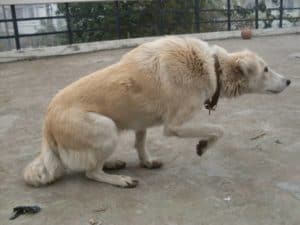When approached by an off-leash dog, it’s totally normal to feel some anxiety or even fear. And if you’re walking your dog when you run across a loose dog, the feelings tend to intensify.
What good is that? All you’re doing is adding to the situation.
So, what should you do when an off-leash dog approaches you while you’re walking your dog?
Always have a few items with you for protection and learn how to read a dog’s body language. Walking off in another direction is often best. If a fight is imminent, use whatever is handy to redirect the dog’s attention so that you can leave the area.
Off-leash dogs should raise some level of suspicion. Why are they out roaming around? Are they aggressive? Are their shots up to date? (Maybe I’m the only one whose mind goes that far…)
Dog owners have a responsibility to protect their pups and keep them safe. And while every situation is different, staying alert when you’re out on a walk can help avoid many encounters with strays.
In training, they teach:
- If you spot an off-leash dog while out walking, take a detour or change directions to avoid it, if possible.
- Keep your dog focused on you and avoid allowing them to make eye-contact with the other dog as this can trigger a reaction. (treats in your hand can help with this)
- When approaching a leashed dog, consider crossing the street to avoid potential conflict.
- When a leashed dog approaches and the owner starts reeling in their leash, that may indicate they have unpredictable behavior (lunging, jumping, barking, or even biting). Give them space.
1. Be Prepared Before You Head Out
Being prepared for the unexpected doesn’t take much effort but might prove to be invaluable in the case of an emergency.
Pack a Few Defense Items
At first, the following items may seem like a lot to bring along for each walk, but you’ll be glad you have them should an incident take place. A fanny pack is great for holding all your “just-in-case” items and leaves your hands free to hold your dog’s leash properly.
- A bag of dog treats to distract an approaching dog (and to reward your dog’s obedience).
- Citronella deterrent spray to give a strange dog a firm reminder to keep his distance without causing him serious pain.
- A small umbrella to pop open in front of a loose dog to startle him.
- Halt! dog repellent to fend off an attacking dog (only for extreme circumstances).
- An air horn or loud whistle to surprise the advancing dog and draw the attention of other people for help.
Learn to Correctly Interpret a Dog’s Body Language
A dog’s intentions are fairly easy to read if you know what to look for in their body stance and facial expressions. Let’s briefly go over the differences between a dog that is approaching in a friendly manner and one who is looking for a fight.
A Friendly Dog

A dog approaching to merely say, “Hi. Do you want to be friends?” will typically have a loose, care-free gait and either be wagging his tail or holding it in a relaxed, downward position. There will be no visible tension around the face, the ears will be in a neutral position, and the mouth will usually be slightly open, almost as if smiling.
An Aggressive Dog

A dog displaying dominant aggression will approach with a stiff gait, tense body, and an intense stare. The mouth is typically either closed or displaying lots of teeth. The ears will often be directed forward, and the eyes appear large with the surrounding whites showing. He will carry his head and tail defiantly high and his fur may either appear puffed up all over or be raised along the ridge of his back.
2. Remain Calm
When approached by an off-leash dog, the most important thing to do is to remain calm. Dogs are quite skilled at picking up on your emotions, and your response will greatly influence the outcome of the encounter.
If your dog senses that you’re frightened, he could display fearful behavior as well or go into defense mode and initiate a fight. Stay calm and be the leader.
3. Assess the Situation
Take a few seconds to carefully note your surroundings in case you need to make a quick escape. Are there people nearby? Are there parked cars or trash cans lining the street? Can you cross the street easily? Is there a fenced yard that you could enter? You get the idea.
Next, pay attention to the approaching dog’s body language while remembering to avoid direct eye contact which could be interpreted as a threat. Determine if the body language is friendly or menacing.
How to Handle a Friendly Dog
If you’re certain that the dog is friendly, you have two options. You can either simply head off in another direction while telling the strange dog, “NO!” (the recommended option), or you can allow the dogs to greet each other politely and then go on your way.
When allowing the dogs to meet, it’s usually best to turn yourself and your dog slightly to the side and direct your dog to sit. Talk softly to both dogs as the new dog draws near. Watch for any signs of aggression.
As long as both dogs are behaving well, allow them to sniff each other. After a few seconds (don’t let it continue for longer than that), say something like, “Okay Muffin, let’s go,” in an upbeat tone, toss a handful of treats off to the side and walk away. The other dog should take the hint.
Should the dog continue to follow you, stop, face the dog, and point in another direction while saying, “No!” or, “Go home!” If he persists, enlist the help of a passerby. Ask them to distract the dog while you walk away.
How to Handle Dog Aggression and Avoid a Fight
An aggressive dog requires an entirely different approach. Avoid eye contact, be glad you packed your defense items and use the following tips:
- Move behind a parked car or another physical barrier.
- Toss some treats on the ground and cross the street.
- Don’t turn your back to the dog or run away.
- Throw treats in his face to momentarily distract him.
- If he gets too close, use the umbrella, citronella spray, or air horn to startle him into thinking twice about attacking.
What to Do When Your Dog Is Attacked
When the worst-case scenario occurs and a fight breaks out, remember these four things:
- Nothing is more important than your safety.
- Fights often sound worse than they really are and usually only last a moment.
- Don’t place your hands or arms anywhere near the dogs.
- Fighting dogs will unintentionally bite you.
Know that fights can be unpredictable and dangerous for all involved, and no intervention method completely guarantees your safety.
The first thing to do is to shout for help. While you wait for assistance, whip out your defense items. Your goal is to redirect their focus briefly so you and your dog can move away.
- Blast the air horn right over their heads.
- Blow your whistle loudly.
- Spray the citronella canine repellent at the attacker.
- Break out the Halt! and aim for the aggressor’s face.
- Place the open umbrella in between the dogs as a barrier (or use a nearby trash can lid)
- Toss your jacket over their heads to startle them.
- If possible, grab a neighbor’s hose and spray them down.
Some trainers recommend the wheelbarrow method if there is someone to assist you. This involves each person grabbing a dog’s back legs and pulling the dogs apart and turning them away from each other. This will work in some instances, but the more physically involved you become, the greater the chance you’ll get hurt. Use this step with caution.
Once the dogs have separated, grab your dog’s leash and leave the area immediately. Don’t run, but get out of there quickly. At home, check your dog all over for any injuries, head to the veterinarian if necessary, and call your animal control office to report the incident and the dog as a final step.
Frequently Asked Questions
What do you do when a dog approaches you?
You want to be prepared for encountering an unleashed dog. Consider bringing some citronella spray as a deterrent if needed or even some treats to toss as a distraction. Be aware of what’s happening around you at all times. Situations can change fast, so you want to be alert. When an off-leash dog approaches, remain calm, avoid making eye contact.





